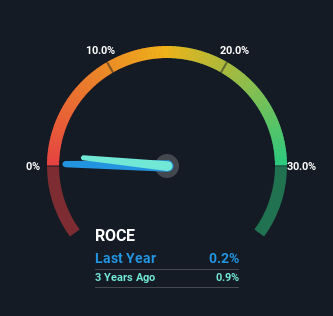These Return Metrics Don't Make Southern Packaging Group (SGX:BQP) Look Too Strong
When researching a stock for investment, what can tell us that the company is in decline? More often than not, we'll see a declining return on capital employed (ROCE) and a declining amount of capital employed. This indicates the company is producing less profit from its investments and its total assets are decreasing. Having said that, after a brief look, Southern Packaging Group (SGX:BQP) we aren't filled with optimism, but let's investigate further.
Return On Capital Employed (ROCE): What Is It?
For those who don't know, ROCE is a measure of a company's yearly pre-tax profit (its return), relative to the capital employed in the business. Analysts use this formula to calculate it for Southern Packaging Group:
Return on Capital Employed = Earnings Before Interest and Tax (EBIT) ÷ (Total Assets - Current Liabilities)
0.0018 = CN¥1.2m ÷ (CN¥1.3b - CN¥612m) (Based on the trailing twelve months to June 2022).
So, Southern Packaging Group has an ROCE of 0.2%. Ultimately, that's a low return and it under-performs the Packaging industry average of 9.4%.
View our latest analysis for Southern Packaging Group

While the past is not representative of the future, it can be helpful to know how a company has performed historically, which is why we have this chart above. If you want to delve into the historical earnings, revenue and cash flow of Southern Packaging Group, check out these free graphs here.
What Does the ROCE Trend For Southern Packaging Group Tell Us?
We are a bit worried about the trend of returns on capital at Southern Packaging Group. To be more specific, the ROCE was 7.6% five years ago, but since then it has dropped noticeably. And on the capital employed front, the business is utilizing roughly the same amount of capital as it was back then. This combination can be indicative of a mature business that still has areas to deploy capital, but the returns received aren't as high due potentially to new competition or smaller margins. So because these trends aren't typically conducive to creating a multi-bagger, we wouldn't hold our breath on Southern Packaging Group becoming one if things continue as they have.
On a side note, Southern Packaging Group's current liabilities have increased over the last five years to 48% of total assets, effectively distorting the ROCE to some degree. Without this increase, it's likely that ROCE would be even lower than 0.2%. And with current liabilities at these levels, suppliers or short-term creditors are effectively funding a large part of the business, which can introduce some risks.
The Bottom Line
In summary, it's unfortunate that Southern Packaging Group is generating lower returns from the same amount of capital. Investors haven't taken kindly to these developments, since the stock has declined 45% from where it was five years ago. That being the case, unless the underlying trends revert to a more positive trajectory, we'd consider looking elsewhere.
On a final note, we found 4 warning signs for Southern Packaging Group (3 don't sit too well with us) you should be aware of.
While Southern Packaging Group isn't earning the highest return, check out this free list of companies that are earning high returns on equity with solid balance sheets.
New: Manage All Your Stock Portfolios in One Place
We've created the ultimate portfolio companion for stock investors, and it's free.
• Connect an unlimited number of Portfolios and see your total in one currency
• Be alerted to new Warning Signs or Risks via email or mobile
• Track the Fair Value of your stocks
Have feedback on this article? Concerned about the content? Get in touch with us directly. Alternatively, email editorial-team (at) simplywallst.com.
This article by Simply Wall St is general in nature. We provide commentary based on historical data and analyst forecasts only using an unbiased methodology and our articles are not intended to be financial advice. It does not constitute a recommendation to buy or sell any stock, and does not take account of your objectives, or your financial situation. We aim to bring you long-term focused analysis driven by fundamental data. Note that our analysis may not factor in the latest price-sensitive company announcements or qualitative material. Simply Wall St has no position in any stocks mentioned.
About SGX:BQP
Southern Packaging Group
An investment holding company, engages in the manufacture and trading of flexible and rigid packaging products in the People's Republic of China, Australia, Thailand, the Philippines, and internationally.
Slight risk and slightly overvalued.
Market Insights
Community Narratives



